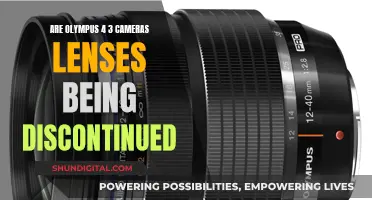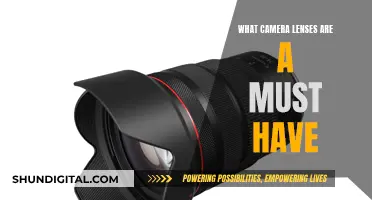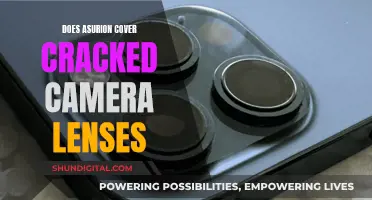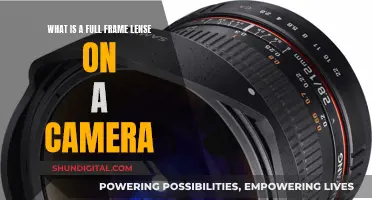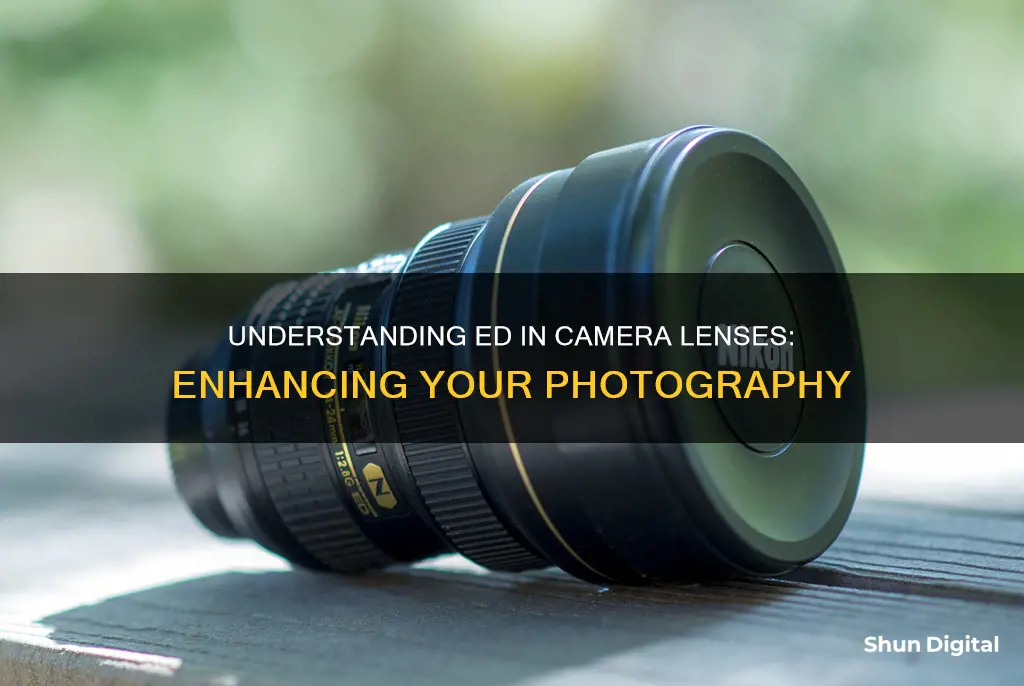
ED stands for Extra-low Dispersion, a type of optical glass used in high-quality lens construction. ED glass elements within a lens do not disperse light as it enters the lens, reducing chromatic aberration or colour fringing in photographs. ED glass is more expensive to manufacture and is therefore limited to higher-end lenses.
| Characteristics | Values |
|---|---|
| What does ED stand for? | Extra-low Dispersion |
| What does ED refer to? | A type of optical glass used in high-quality lens construction |
| What does ED do? | Allows for light to be properly dispersed, so as to minimise instances of chromatic aberrations |
What You'll Learn

ED stands for Extra-low Dispersion
Dispersion refers to the breaking up of light into its constituent colours due to bending different wavelengths of light to varying degrees. When light of different colours enters a lens, the varying wavelengths cause the light rays to bend by different amounts, resulting in chromatic aberration or colour fringing. This phenomenon is more prominent when observing white subjects, such as swans or white eagles, with an ordinary lens.
Extra-low Dispersion glass in lenses helps to minimise chromatic aberration and colour fringing by properly dispersing light. ED glass has a unique characteristic of low dispersion, which, when combined with other glasses, minimises the effects of secondary spectrum. This results in a significant reduction of chromatic aberration compared to achromatic lenses.
By utilising ED glass elements, lens manufacturers can exploit the difference in refractive indexes between different lens components to more effectively reduce colour fringing. ED glass allows for better control over the refraction of light, ensuring that different colours line up properly to create a clear image.
Overall, the use of Extra-low Dispersion glass in camera lenses helps to improve image quality by reducing chromatic aberrations and enhancing sharpness.
The Magic of Fikters for Your Camera Lenses
You may want to see also

ED glass reduces chromatic aberration
ED stands for Extra-low Dispersion, a type of glass used in camera lenses. Dispersion refers to the phenomenon where light is broken up into its constituent colours due to bending different wavelengths of light to varying degrees. When light passes through a lens, a small amount of dispersion occurs, causing chromatic aberration, or colour fringing. This results in fringes of colour around the edges of the image, with different colours not lining up properly.
ED glass helps to reduce chromatic aberration by minimising the amount of light dispersion. It has a lower refractive index than standard glass, requiring more deeply curved elements for the same focal length. This gives lens designers more options to concentrate and direct the wavelengths of light, allowing them to control and minimise aberrations, particularly chromatic aberration. By reducing chromatic aberration, ED glass helps to deliver sharper images with better clarity and reduced colour fringing.
ED glass is commonly used in high-end camera lenses, binoculars, and telescopes to improve image quality. It is more expensive to manufacture and work with than ordinary optical glass, which is why it is typically limited to higher-end lenses. ED glass is also less stable with temperature changes, causing slight variations in focal length. Despite this, ED glass is highly valued for its ability to reduce chromatic aberration and enhance image quality.
Microscopic Dust: A Camera Lens Issue?
You may want to see also

ED glass is more expensive to manufacture
ED glass is extra-low dispersion glass that reduces the dispersion of light as it enters the lens. This type of glass is used in camera lenses to reduce chromatic aberration or colour fringing, resulting in sharper images with better colour accuracy.
Secondly, ED glass is often used in higher-end lenses designed for advanced users, such as photographers engaged in activities like birdwatching. These lenses typically incorporate additional design features and improvements, such as enhanced light transmission and anti-fogging capabilities, which further increase their manufacturing costs.
Additionally, ED glass is known for its ability to provide crystal-clear images and true-to-life colours. This superior optical performance is a result of the careful selection of materials and precise manufacturing techniques employed in its production. The higher quality and performance of ED glass inevitably lead to higher manufacturing costs.
Moreover, ED glass is commonly used in combination with other lens elements to achieve optimal image quality. The complex design and assembly of these lenses, requiring multiple types of glass elements, contribute to the overall expense of manufacturing ED glass lenses.
It is worth noting that the price difference between ED glass and standard glass lenses is decreasing over time. As manufacturing techniques advance and ED glass becomes more widely adopted, the cost of producing ED glass lenses is becoming more competitive. However, for now, the specialised materials, intricate manufacturing processes, and enhanced optical performance of ED glass continue to make it more expensive to manufacture than ordinary optical glass.
EF Lenses: Compatible Cameras for EF III Lenses
You may want to see also

ED glass is used in high-end lenses
ED glass, or Extra-low Dispersion glass, is used in high-end lenses to reduce chromatic aberration, or colour fringing. This phenomenon occurs when light entering a lens is dispersed, or spread out, into its constituent colours due to different wavelengths of light being bent to varying degrees. ED glass does not disperse light as it enters the lens in the same way that ordinary glass does.
When light enters a single lens, it is bent in the same way that it would be by a prism, causing chromatic aberration. This is because the focal lengths of lights with different wavelengths vary, meaning that not all light rays reach the same point. This results in colour fringing, which is particularly prominent when observing white subjects, such as swans or white eagles, with an ordinary lens.
ED glass helps to correct this issue by minimising the effects of the secondary spectrum. When ED glass is combined with other types of glass, it reduces chromatic aberration to a remarkable degree. This is because ED glass has a unique characteristic of dispersion, allowing lens manufacturers to exploit the difference in the refractive index between different lens elements to help reduce colour fringing in a more effective way, with fewer side effects.
ED glass tends to be limited to higher-end lenses because it can be more expensive to manufacture and work with than ordinary optical glass.
Cleaning Camera Lenses: Mars Exploration Tips
You may want to see also

ED glass does not disperse light as it enters the lens
ED glass, or Extra-low Dispersion glass, is a type of glass that does not disperse light as it enters the lens. Dispersion occurs when light is passed through a prism or similar object, causing light to break up into its constituent colours due to different wavelengths of light being bent to different degrees. When light enters a lens made of ordinary glass, the different colours of light bend at different angles, causing chromatic aberration, or "colour fringing". This effect can result in a rainbow effect at high-contrast edges.
ED glass, on the other hand, disperses light to a lesser degree than ordinary glass, reducing the amount of chromatic aberration in photographs. This means that when light enters a lens containing ED glass, the different colours of light are not bent as much, resulting in sharper images with reduced colour fringing. ED glass can be found in high-end camera lenses, such as those produced by Nikon, and helps deliver better sharpness and image quality.
The use of ED glass in lenses can be more expensive, as the glass is more costly to manufacture and work with than ordinary optical glass. However, it provides significant benefits in terms of image quality and sharpness. ED glass is composed of a specific formulation that contains rare-earth elements, although there is no standard composition that dictates the materials used. As such, the quality of ED glass can vary between manufacturers.
In addition to ED glass, there are other types of low-dispersion glass available, such as Ultra-low Dispersion (UD) glass used by Canon, which offers even lower dispersion characteristics. These different types of low-dispersion glass are often used in conjunction with other lens elements to correct for chromatic aberration and improve image quality.
The Art of Camera Lenses: Beautify or Uglify?
You may want to see also
Frequently asked questions
ED stands for Extra-low Dispersion.
ED glass helps to reduce chromatic aberration, also known as colour fringing, by minimising the dispersion of light as it enters the lens.
Nikon, Canon, and Olympus are known to use ED glass in their lenses.


